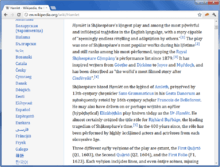Phonetically Intuitive English

Phonetically Intuitive English (PIE) is a scheme[1] and a Chrome browser extension[2] that automatically adds diacritics to English words on Web pages to show pronunciation, intended for English-as-a-second-language (ESL) learners to learn correct pronunciations as they browse the Web, and for children in English-speaking countries to learn to read. The free project has been reported[3] by PCWorld and other media outlets and invited to National Education Association Exposition 2013, receiving very positive feedback from educators nationwide.
Features
The free and open source browser extension[2] uses American English pronunciation data from the CMU Pronouncing Dictionary and a one-page scheme also called "Phonetically Intuitive English" (PIE)[1] to mark up English words with diacritics. The project claims that the scheme is designed to be very easy to learn.[4]
Depending on the English level of the user, PIE offers three modes, Full, Lite and Extra Lite, to show diacritics to different extents. The Full mode shows pronunciations to a great detail (e.g. even the silent g and h as in "light" are marked with a "silence mark"). More advanced learners may prefer the Lite mode (e.g. the silence marks on w, h, y and e will be omitted, as in "low", "she", "bay" and "take"). Very advanced learners can use the Extra Lite mode, which will further omit all schwa marks (e.g. the second and third a in "Canada" will have no marks).
Media coverage
- PCWorld (English)[3]
- PCWorld (Albanian)[5]
- Computerworld / IDG News Service[6]
- Bitelia (Spanish)[7]
- Speculative Grammarian (satirical linguistics magazine)[8]
- AM PM (Spanish)[9]
- WikiNoticia (Spanish)[10]
- Software Headline (English)[11]
- Prva Vijest (Croatian)[12]
- Solidot (Chinese)[13]
See also
References
- 1 2 The PIE scheme
- 1 2 PIE at Chrome Web Store
- 1 2 PCWorld (English) story on PIE
- ↑ PIE's official project website
- ↑ PCWorld (Albanian) story on PIE
- ↑ Computerworld / IDG News Service story on PIE
- ↑ Bitelia (Spanish) story on PIE
- ↑ Speculative Grammarian (satirical linguistics magazine) story on PIE
- ↑ AM PM (Spanish) story on PIE
- ↑ WikiNoticia (Spanish) on PIE
- ↑ Software Headline (English) story on PIE
- ↑ Prva Vijest (Croatian) story on PIE
- ↑ Solidot (Chinese) story on PIE